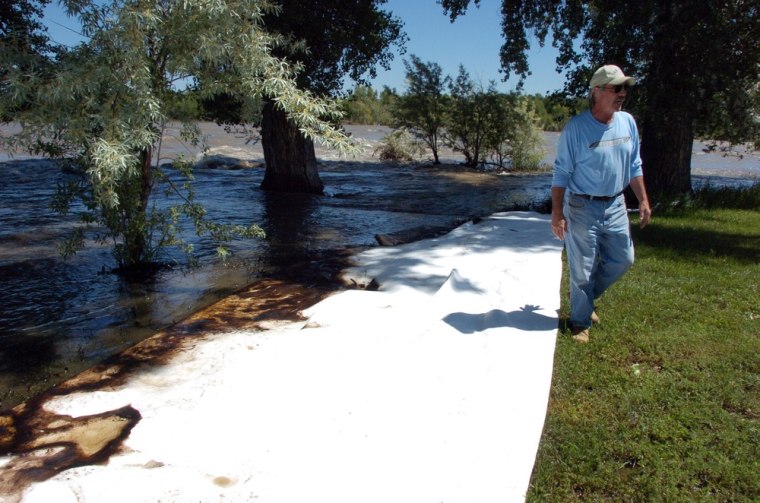An ExxonMobil pipeline that runs under the Yellowstone River near Billings in south-central Montana ruptured and dumped up to 1,000 barrels of oil, fouling the riverbank and forcing water intakes downstream to be closed.
Company spokeswoman Pam Malek said the pipe broke about 11:30 p.m. Friday and leaked for about a half-hour.
The cause of the rupture in the pipe carrying crude oil from Belfry, Mont., to the company's refinery in Billings wasn't known. But Duane Winslow, disaster and emergency services coordinator for Yellowstone County, told NBC station KULR8 that erosion from high water this spring likely played a role.
Brent Peters, the fire chief for the city of Laurel about 12 miles east of Billings, said the break in the 12-inch diameter pipe occurred about a mile south of Laurel. Crews shut down the pipeline about half an hour later.
Peters said about 140 people were evacuated starting about 12:15 a.m. Saturday due to concerns about possible explosions and the overpowering fumes. All were allowed to return after instruments showed fumes had decreased. He said more evacuations occurred farther downstream outside his district.
Gov. Brian Schweitzer and Sen. Max Baucus called for a swift cleanup.
In a statement Saturday, ExxonMobil said it was sending its North American Regional Response Team to the area to help with cleanup work, and that state and federal authorities had been alerted to the spill from the pipe belonging to the ExxonMobil Pipeline Company.
The company "deeply regrets this release and is working hard with local emergency authorities to mitigate the impacts of this release on the surrounding communities and to the environment," the statement said.
Oil had washed ashore from Laurel to Pompeys Pillar, a distance of nearly 50 miles by Saturday afternoon, according to KTVQ, a CBS affiliate in Billings. The fast moving river pushed the sheen to the east.
The river has no dams on its way to its confluence with the Missouri River just across the Montana border in North Dakota. It was unclear how far the plume might travel.
A 600-foot-long black smear of oil coated the riverfront property of Jim Swanson just downstream from where the pipe broke.
"Whosever pipeline it is better be knocking on my door soon and explaining how they're going to clean it up," Swanson said as globules of oil bubbled to the surface of the river. "They say they've got it capped off. I'm not so sure."
Crews put out absorbent material along short stretches of the river in Billings and near Laurel. There appeared to be no attempts at capturing oil farther out in the river, and the smell of oil permeated the air for miles downstream and through the city of Billings.
ExxonMobil officials said cleanup crews of up to about 140 workers were expected to arrive in the area with 36 hours.
"Nobody's been able to lay their eyes on the pipe," Peters said. "Right now the Yellowstone River is at flood stage. The bank isn't stable enough for anybody to get close."
The cause of the break is not known, but Peters and Malek said speculation involves high water flowing through the river that might have gouged out the river bed and exposed the pipe, which was possibly hit by debris.
"I haven't seen it this high for at least 15 years," Peters said.
Jeb Montgomery, with the ExxonMobil Pipeline Co., said the pipe was buried six feet below the riverbed.
The state has received record rainfall in the last month and also has a huge snowpack in the mountains that is melting, which has resulted in widespread flooding in recent weeks.
Three oil refineries are in the Billings area, and Peters said he asked all three to turn off the flow of oil in their pipelines under the river once the leak was reported. He said ExxonMobil and Cenex Harvest Refinery did so, and that Conoco Phillips said its pipe was already shutdown.
He said the river where the leak occurred is about 250 yards wide, and that early Saturday morning an oil slick appeared to be about 20 feet wide.
"That was the farthest my flashlight would reach," he said.
Laurel, which has a population of about 6,500, is known for a huge Fourth of July fireworks display put on by the fire department, which has its own pyrotechnics crew. Peters said the town can swell to as many as 50,000 people for the event.
He said the fire department plans to hold the event on Monday.
In 1989, an Exxon oil tanker leaving Valdez, Alaska, struck a reef in Prince William Sound and spilled millions of gallons of crude into the sea. The disaster led to widespread deaths of wildlife and a lengthy legal battle pitting residents whose livelihoods were decimated against the oil company.
The Associated Press and Reuters contributed to this report.
